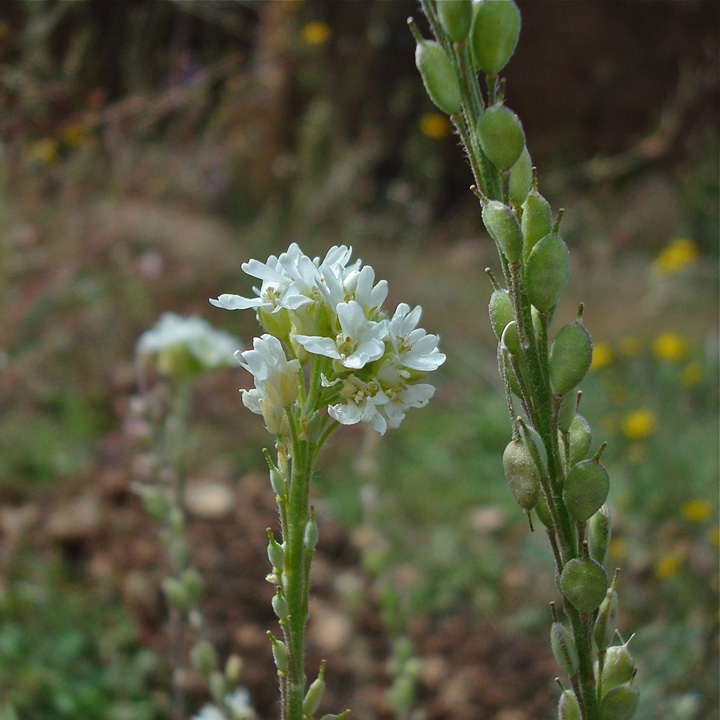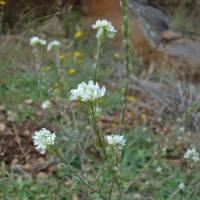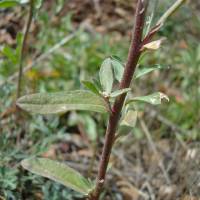|
|
|
|
Family: Brassicaceae
hoary alyssum
[Alyssum incanum L.] |
Plants densely pubescent, trichomes appressed, stellate mixed with simple ones. Stems simple or few from base, (2-)3-8(-11) dm. Basal leaves (withered by flowering) : blade oblanceolate, (2.5-)3.5-8(-10) cm, base cuneate or attenuate, apex obtuse. Cauline leaves: blade apex acute or obtuse. Fruiting pedicels appressed to rachis, (4-)5-9(-12) mm. Flowers: sepals 2-2.5 mm; petals narrowly obcordate, (4-)5-6.5(-8) mm (lobes oblong, (1-)1.5-3 × 0.5-1.5 mm); filaments white, median pair 2-3.3 mm, lateral pair 0.3-1 mm; anthers 0.5-1 mm. Fruits (4-)5-8.5(-10) × (2-)2.5-4 mm; valves obtuse at both ends, trichomes sometimes with unequal rays; style 1-4 mm, sparsely pubescent basally. Seeds slightly flattened, narrowly margined, 1-2.3 mm diam. 2n = 16. Flowering May-Sep. Flood plains, meadows, waste places, railroad embankments, woodlands, grasslands, roadsides, fields, stream banks, pastures, hillsides, forest floor; 0-2800 m; introduced; B.C., Man., N.B., Ont., Que., Sask.; Ariz., Calif., Colo., Conn., D.C., Idaho, Ill., Ind., Iowa, Kans., Maine, Mass., Mich., Minn., Mo., Mont., Nebr., Nev., N.H., N.J., N.Y., N.Dak., Ohio, Oreg., Pa., R.I., S.Dak., Utah, Vt., Va., Wash., W.Va., Wis., Wyo.; Europe; Asia. Annual or perennial herb to 0.7 m tall Stem: stiffly upright, usually branched above, covered with grayish, star-shaped hairs. Leaves: alternate, stalkless, 2 - 5 cm long, nearing 1 cm wide, reverse lance-shaped with a rounded to pointed tip, covered with grayish, star-shaped hairs. Flowers: in dense, rounded clusters, white, 5 - 7 mm long. Petals four, deeply two-lobed. Stamens six. Ovary green, densely hairy. Fruit: a thick pod, 5 - 8 mm long, 3 - 4 mm wide, elliptic, nearly round in cross-section, thinly hairy. Seeds three to six per chamber. Similar species: Berteroa incana is the only representative of the genus Berteroa in the Chicago Region. Its deeply lobed petals and grayish, star-shaped hairs are distinctive. Flowering: late May to late September Habitat and ecology: Introduced from Europe. A common weed of roadsides and fields. It also grows along railroad tracks. Occurence in the Chicago region: non-native Etymology: Berteroa refers to the Italian physician C.G.L. Bertero (1789-1831) who botanized in Guadeloupe and other West Indian islands. Incana means hoary; gray or silver colored. Author: The Morton Arboretum Stellate-canescent annual to perennial, stiffly erect, usually branched above, to 7 dm; lvs oblanceolate, (1-)2-5 cm, acute, entire; fls white, 3 mm wide; fr elliptic, plump, thinly hairy, 5-8 נ3-4 mm, convex over the whole surface; seeds 3-6 per locule; 2n=16. Native of Europe, established as a weed throughout much of our range, especially northward. Gleason, Henry A. & Cronquist, Arthur J. 1991. Manual of vascular plants of northeastern United States and adjacent Canada. lxxv + 910 pp. ©The New York Botanical Garden. All rights reserved. Used by permission. |





